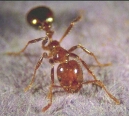Killer ants
|
|
Killer ants is a term to describe any of several species of ants that are predatory, attack en masse when their mounds are disturbed, and can kill animals many times their size, even deer if they are immobilized. They have been called the fiercest predators on Earth. Predator ants kill more individuals than all the big predators combined.
The most commonly cited example of killer ants are the Red Imported Fire Ants (RIFA, IFA, Solenopsis invicta).
Other kinds of killer ants include:
|
Name |
Range |
Comments |
|---|---|---|
|
The first two entries are velvet ants (all ants are related to wasps, but velvet ants really are wasps). Reference (http://ag.arizona.edu/urbanipm/insects/bees/velvetants.html) | ||
|
Velvet Ants: Cow killers (Dasymutilla occidentalis) |
Eastern USA |
A fanciful name; they cannot kill animals as large as cows. |
|
Velvet Ants: Red velvet ants (Dasymusilla magnifica) |
Western USA |
|
|
Argentine ants (Linepithema humile) |
Argentina, Southern Europe, Southern USA, California |
Very small, attack mostly other ants. The main supercolony (Italy, Atlantic coast of Spain) is said to be the largest cooperating ant population in the World. |
|
Pharaoh ants (Monomorium pharaonis) |
Worldwide |
In February 2000, an invasion of Pharaoh ants terrorized office workers in Berlin, Germany. |
|
Red harvester ants (Pogonomyrmex barbatus) |
Western USA |
Bright red myrmicine ants whose venom has the highest relative azoicity of any ants species. Images (http://www.tightloop.com/ants/pogbar.htm) |
|
Bulldog ants (Soldier ants, Genus Myrmecia) |
Australia |
They are said to be repelled by yellow objects. Belonging to the subfamily Myrmecinae, these are the most primitive extant ants. All but one of the three score or so species are found in Australia. |
|
Bullet ants (Paraponera clavata) |
range? |
Bullet ants, and their close relatives of the genus Dinoponera are New World ponerines. |
|
Honeypot ants (genus Myrmecocystus) |
range? |
(It is claimed that these are really harmless ants. An expert opinion is needed.) M. mendax is rather attractively coloured and diurnal, whereas the darker species such as M. californicus tend to be more active during the night. |
|
Legionnaires / Amazon ants (Polyergus breviceps) |
range? |
Polyergus are most interesting southern boreal obligate dulotes of the Formicinae subfamily. Their host is, like a similar convergent species, Formica sanguinea, ants of the Formica fusca group. Although absent from the British Isles, Polyergus rufescens is present on the continent, and many observations of its behaviour were made by Forel. Like the unrelated British-found parasite to tetramorium caespitum, Strongylodus testaceus (first discovered in Britain by Horace Donisthorpe), the Legionnaires display greatly adapted, strongly falcate mandibles, which they use for piercing the heads of F. fusca et. al. during raids. |
|
Yellow crazy ants (Anoplolepis gracilipes) |
range? |
Kill red crabs on Christmas Island, and generally destroy the ecosystem for the other 17 species of terrestrial crab found there, including the largest terrestrial invertebrate in the known world. |
|
New World Army ants (Eciton spp.) |
South America, Southern Mexico |
See below; Reference (http://animaldiversity.ummz.umich.edu/accounts/eciton/e._burchelli%24narrative.html) The New World army ants have recently been separated from the Dorylinae. |
|
Driver ants (Subfamily Dorylinae) |
The Old world, esp. West Africa and the Congo Basin |
See below. |
Army and Driver ants appear to be the most dangerous of the killer ants. Driver ants can reduce a tethered cow to polished bone in several weeks. A few cases of human deaths (inebriated or infant) have been reported.
Unlike the army ants of the New World, Old World army ants lack a functional sting, but this is more than compensated for by their razor-sharp, falcate mandibles. Dorylus spp. colonies also reach larger sizes than Eciton.
Pictures
These images are copyrighted as indicated, and are used by permission (see Talk page for details) from the author, Bart Drees, Director, Texas Imported Fire Ant Project, Department of Entomology, Texas A&M University.
Many more images like these can be seen at their Fire Ant Web site (Home Page (http://fireant.tamu.edu/), Photos (http://fireant.tamu.edu/materials/graphics/photo/photo.html)).
|
Cow killer ants |
Missing image
CowKillerDrees.jpg |
|
Crazy ants |
Missing image |
|
Pharaoh ants |
Missing image |
|
Red Harvester ants | |
|
Red Imported Fire Ants |
See also
Killer ants in popular culture
You may be looking for horror movies or books involving fanciful killing ants. These include:
- Them! (1954)
- The Naked Jungle (1954)
- The Monolith Monsters (1957)
- Phase IV (1973)
- The Deadly Invasion (1973)
- Ants (1977 - TV movie)
- Empire of the Ants (1977 - movie and novel) Based on a story by H.G. Wells.
- The Nest (1987) Killer cockroaches
- Arachnophobia (1990) Killer spiders
- Attack of the Killer Ants (1996 - novel)
- Legion of Fire: Killer Ants! (1998 - TV movie)


